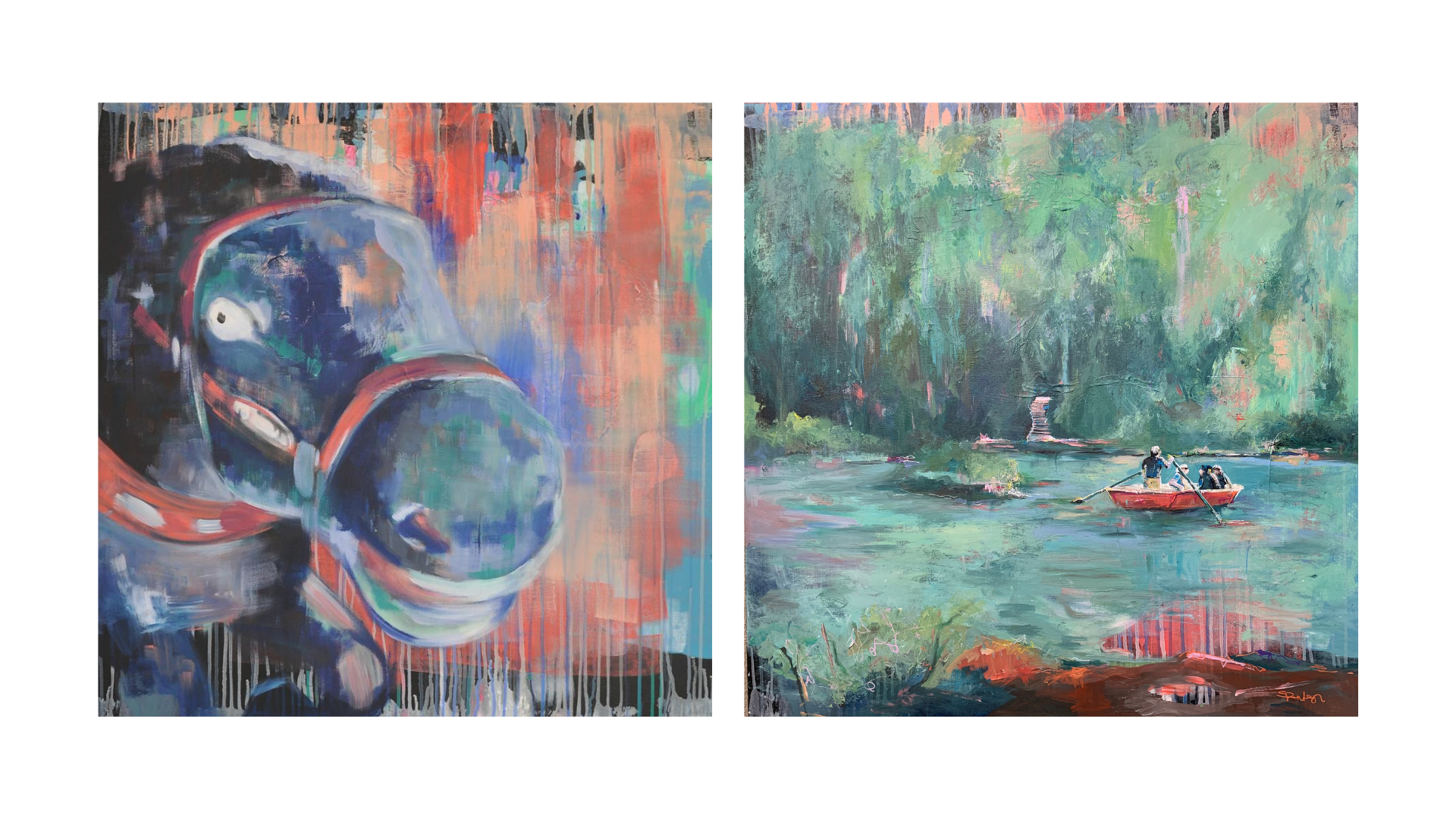The arts and leadership are closer to one another than it seems.
What do leaders and artists have in common?
The American painter, Robert Henri, said it powerfully:
“When the artist is alive in any person, whatever their kind of work may be, they become an inventive, searching, daring, self-expressive creature. They disturb, upset, enlighten, and open ways for better understanding.”
That sounds a lot like leadership.
I know I’ve learned some of my most important lessons about leadership through my diverse experiences as an internationally exhibited self-taught artist, team-building facilitator and HR professional. Here are five things that have stood out to me and that could help other leaders.
Artists and leaders bring visions to life
The first parallel between leadership and art is about visions. Chris Duffin, author and chief visionary officer of fitness brand Kabuki Strength, shares in his interview with Forbes that “The role of a leader is to be a visionary: an artist who brings their values to life through their actions, words, and impact on the world around them.”

Non-fiction author and trainer, Simon Sinek, takes it one step further by suggesting that all CEOs should be renamed as CVOs - Chief Vision Officers. Sinek’s CVO is “in charge of setting and ensuring that the company stays on the path of the vision.”
Where an artist might have a strong vision about a masterpiece they’re creating, a leader’s vision relates to things like company culture, client satisfaction or the societal impact of the organisation.
However, as Benjamin Laker in Forbes points out, the strongest vision alone won’t be enough if it’s not balanced with action. He describes vision and action as a leader’s yin and yang: “two opposite but complementary forces that act in harmony, driving the perfect balance.”
Leaders and artists must balance the idea with concrete actions to bring a vision to life. The artists follow their imagination to turn an idea into a painting, a sculpture or lyrics to a song; leaders turn their visions into an operational plan, project or a finalised product.
Creative intelligence is fuel for leaders
Turning a vision into life is rarely straightforward, and that is the second common point between leadership and art: leaders and artists need to make sense of complex situations and simplify them for others.
Steven S. Taylor, professor and author of Leadership Craft, Leadership Art, calls this process “sensemaking”, and according to him, artists tend to approach it differently than leaders.
Taylor observes that leaders often gravitate towards finding patterns quickly when making sense of complex situations. They are urged to match the situation quickly, squeeze it into an existing pattern, and act based on that pattern.
However, Taylor suggests a creative mindset can help leaders approach decision-making situations more like artists. Instead of trying to find the pattern as fast as possible, they can lean into their senses, intuition and emotional intelligence to find new solutions.
Many artists, myself included, use this approach when following their vision to create a new piece of art. For example, the painting below illustrates the explorer’s mindset - both on the theme and the creative process its birth followed.
The process started with a visual metaphor of a merry-go-round horse to symbolise play and freedom of discovery. Yet, once the painting was rendered, I found it scary: the horse’s freaky glass eye didn’t convey the intended message of taking the path less trod.

However, I chose to approach this detour as insight that will feed into future iterations and the development of better ideas. So, I recycled the painting into this lake scene. Not only did it capture the mindset of an explorer better, but the layers of the previously “failed” painting peeping through as red reflections made the new painting much better than I could have imagined deliberately.
When approached like this, the sensemaking process becomes like a dance between the original vision and new ideas, between the big picture and details. This flexible mindset is a skill that can be developed, and that is one thing we do at Collaborative Art® both in creativity workshops for organisations and in our team-building workshops.
Creativity nurtures resilience
The artistic mindset and creative thinking approach are also helpful when leaders need to navigate uncomfortable and unpredictable situations - which is, after all, a lot of time!
A culture of creativity can be a powerful tool in nurturing the resilience needed in fast-changing environments.
“By fostering a culture that supports creativity, you indirectly strengthen resilience. When employees are encouraged to think creatively, they also develop the mindsets and skillsets essential for resilience and innovation”, writes Linda Naiman in her Association of Talent Development blog article.
In return, promoting resilience also fosters creativity.
“When employees are taught ways to bounce back from adversity, they are more likely to take risks and generate new ideas, and less likely to be held back by the fear of failure, which can stifle creativity”, Naiman continues.
This mental flexibility allows leaders and teams to approach setbacks and bumps on the road as information, not failure. It makes bouncing back easier and faster.
Artistic leaders value collaboration
Leaders who lead their teams with an artistic mindset value collaboration over individual accomplishments.
For leaders, this often means letting go of some control and micromanagement to allow creative inputs from more brains than one. It means trusting the process and trusting the team.
In Leadership Craft, Leadership Art, Steven S. Taylor introduces two aspects of collaboration: implicit and explicit. On the one hand, leaders can encourage implicit collaboration by coming into contact with a wide range of exciting inputs from their team, other teams, departments, organisations and even different industries.
On the other hand, explicit collaboration requires stripping off unnecessary hierarchies so that ideas can flow freely between different levels of an organisation.
“Collaboration requires a culture of high mutual respect, a willingness to play, and treating mistakes as interesting opportunities to learn”, Taylor observes.
Leaders can benefit from implicit and explicit collaboration by opening doors to different inputs that allow for greater collaboration and results that are greater than the sum of their parts.
Connection is the real art form of leadership
Leadership and art have many points in common, (from being visionaries to fostering resilience, dialogue and collaboration) but leadership is in and of itself an art form as well: the art of connection.
“Leadership is art, and not metaphorically speaking”, summarises Professor Carol Becker from Columbia University.
“Leaders, like artists, may inspire, motivate, challenge, promote self-expression and out-of-the-box thinking and can change our lives.”
This is one reason I love tying art and teamwork together in the Collaborative Art® team-building workshops. Working together, often in a very manual way, on a tangible project teaches the teams to lean into the collective intelligence of the group, learn from one another and build on what others have already done.
The experience also gives them the courage and confidence to trust their senses and intuition when they return to the workplace.
How are you awakening the creativity of your team?
These are the five lessons I’ve learned from my experience as both an artist and a professional in various fields. Leaning into the mindset of an artist has helped me navigate tricky professional situations and keep growing as a leader.
Of course, none of this is news: philosophy about what outstanding leadership looks like existed over 2,500 years ago. It’s about making your team the heroes and not yourself. The Chinese philosopher, Lao Tzu, summarised this approach to leadership nicely:
“To lead people, walk beside them…As for the best leaders, the people do not notice their existence. The next best people honour and praise. The next, the people fear; the next, the people hate…When the best leader’s work is done, the people say, ‘We did it ourselves!’”
Our Collaborative Art® facilitators strive to bring this feeling of ownership to life. Most people don’t believe in their perceived artistic abilities, but our facilitators aim to make the teams the heroes of artistic team-building challenges and turn their doubts into pride by the end of the workshops.
What do you do to awaken the creative hero within your team members?
About the Author

Steph Fonteyn is an internationally exhibited artist, corporate facilitator and the founder of Collaborative Art® team building. She ties together the fine threads of creativity, courage and leadership to provide her clients with transformative team-building and workshop experiences. Her mission is to empower professionals worldwide to tap into their inherent creativity to be better leaders and bring about change.
Steph founded Collaborative Art® in 2011 to unite teams around a shared vision through art, and she has developed innovative techniques to unlock both the creative and collaborative potential in teams. With her artistic talent, public speaking skills, HR experience, and team-building expertise, Steph has become a respected figure in creativity, communication, and leadership.
As an award-winning public speaker, she has shared her expertise on creativity and courage at various events, including TEDx in 2015.
Steph splits her time between creative artwork and supporting companies through creative, collaborative team-building activities. She lives in Switzerland, near Geneva.